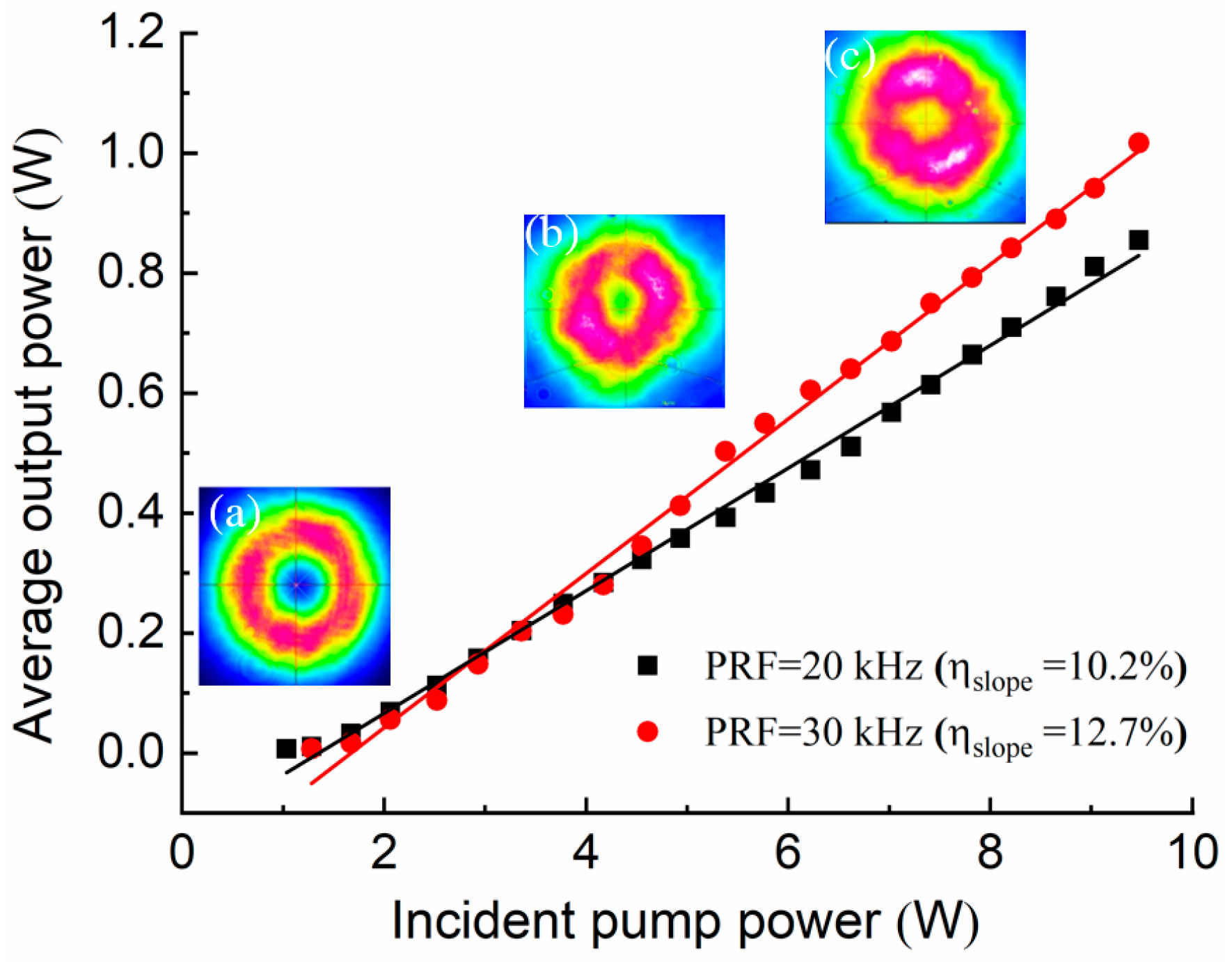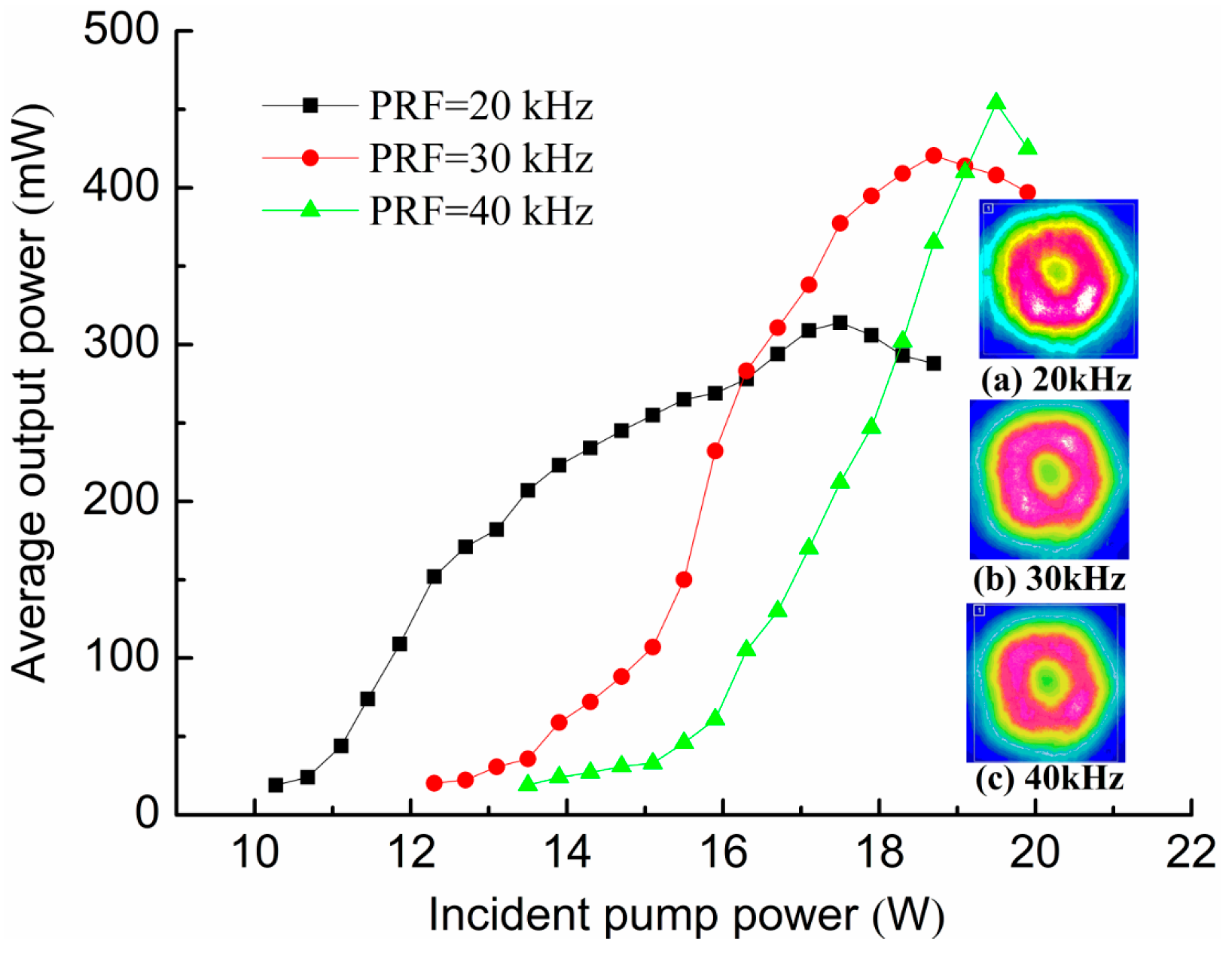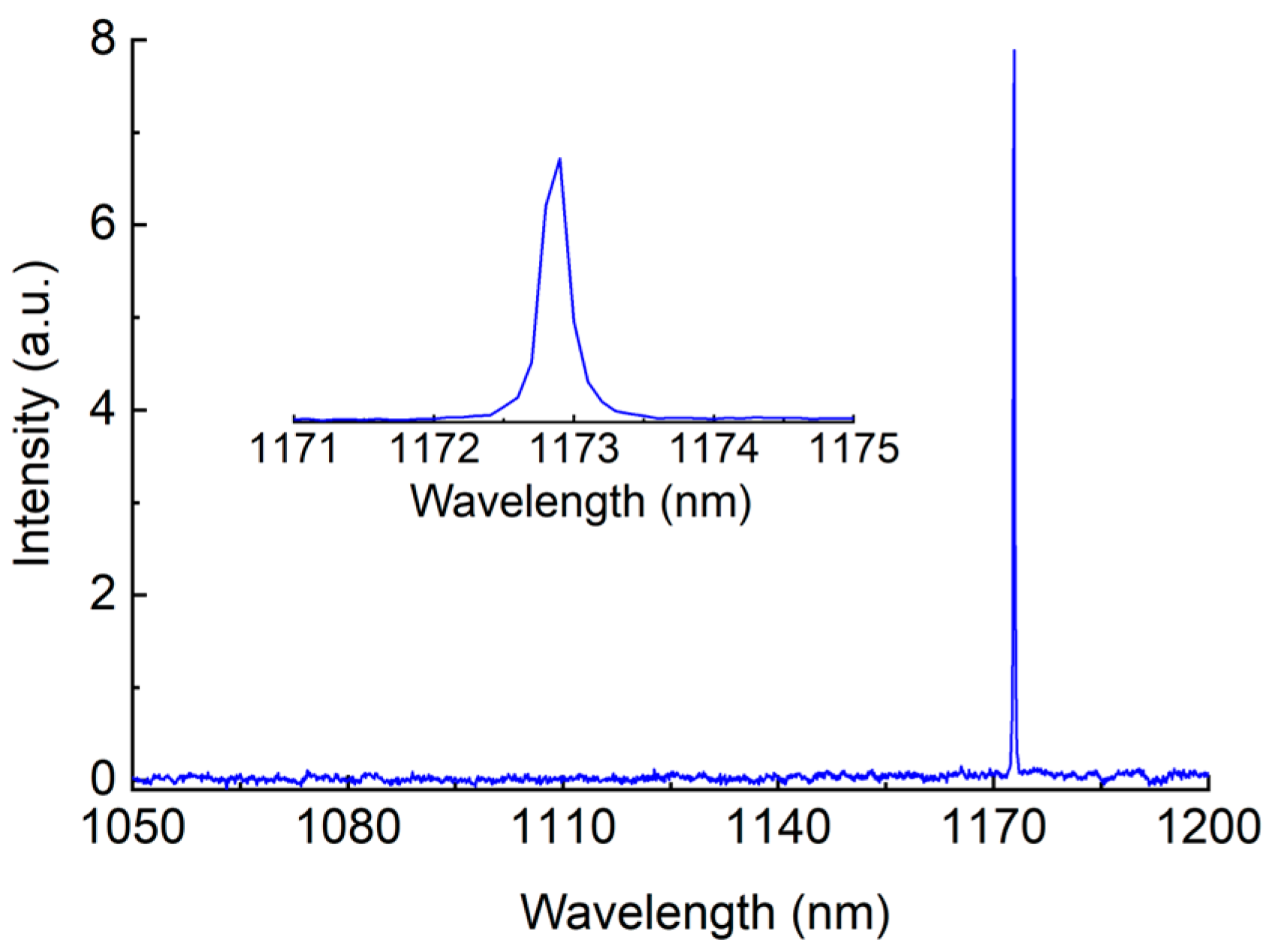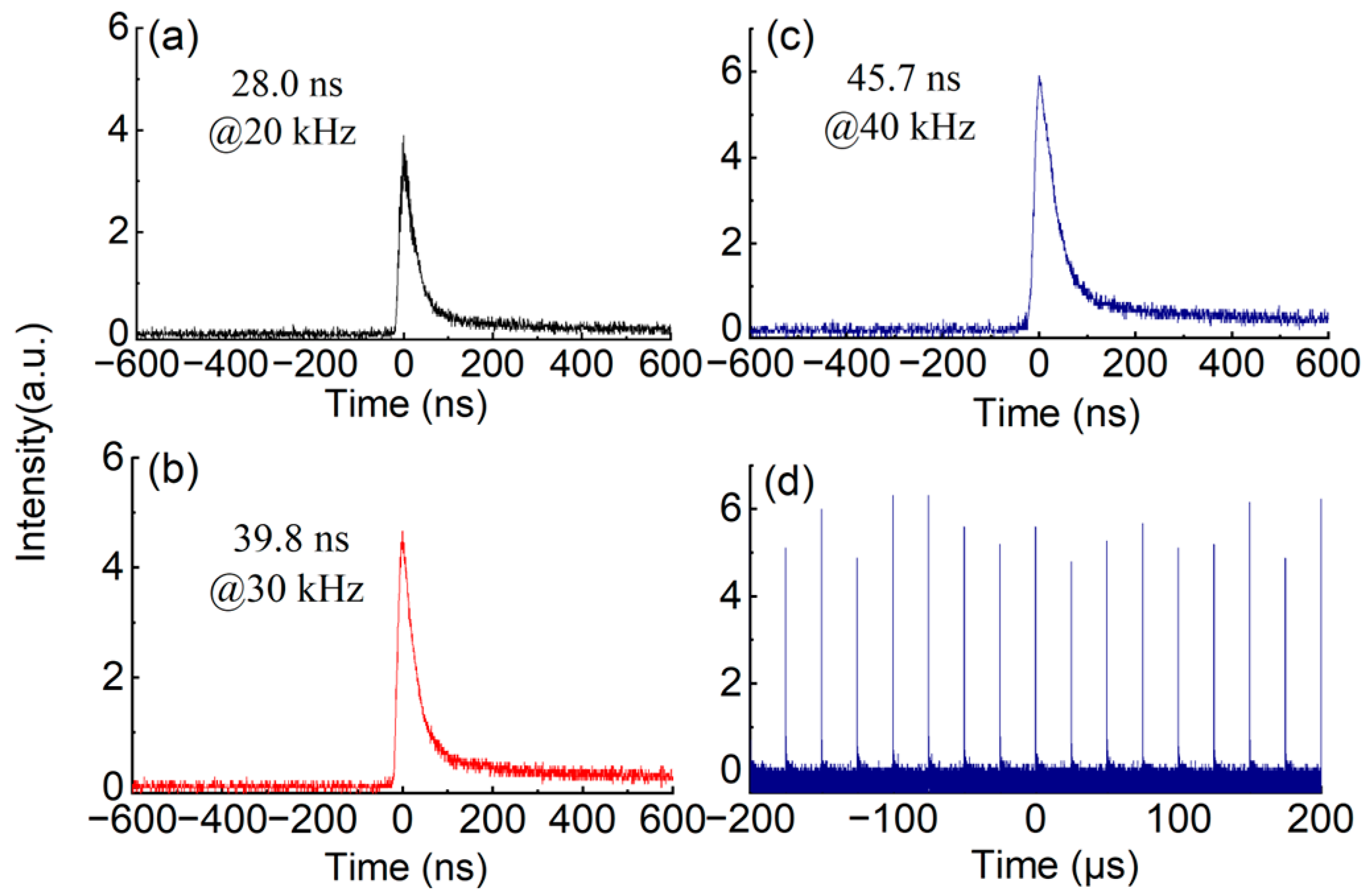An Axicon-Based Annular Pump Acousto-Optic Q-Switched Nd:GdVO4 Self-Raman Vortex Laser
Abstract
:1. Introduction
2. Materials and Methods
3. Results and Discussion
3.1. Acousto-Optic Q-Switched 1063 nm Fundamental Vortex Laser
3.2. Acousto-Optic Q-Switched Self-Raman Vortex Laser
4. Conclusions
Author Contributions
Funding
Data Availability Statement
Conflicts of Interest
References
- Liu, J.; Duan, Y.M.; Li, Z.H.; Zhang, G.; Zhu, H.Y. Recent progress in nonlinear frequency conversion of optical vortex lasers. Front. Phys. 2022, 10, 865029. [Google Scholar] [CrossRef]
- Paterson, L.; Paterson, L.; MacDonald, M.P.; Arlt, J.; Sibbett, W.; Bryant, P.E.; Dholakia, K. Controlled Rotation of Optically Trapped Microscopic Particles. Science 2001, 292, 912–914. [Google Scholar] [CrossRef] [PubMed]
- Gahagan, K.T.; Swartzlander, G.A. Optical vortex trapping of particles. Opt. Lett. 1996, 21, 829–879. [Google Scholar] [CrossRef] [PubMed]
- García-Escartín, J.C.; Chamorro-Posada, P. Quantum multiplexing with the orbital angular momentum of light. Phys. Rev. A 2008, 78, 062320. [Google Scholar] [CrossRef]
- Yang, M.; Zhang, H.Q.; Liao, Y.W.; Liu, Z.H.; Zhou, Z.W.; Zhou, X.X.; Xu, J.S.; Han, Y.J.; Li, C.F.; Guo, G.C. Topological band structure via twisted photons in a degenerate cavity. Nat. Commun. 2022, 13, 2040. [Google Scholar] [CrossRef]
- Moneron, G.; Medda, R.; Hein, B.; Giske, A.; Westphal, V.; Hell, S.W. Fast STED microscopy with continuous-wave fiber lasers. Opt. Express 2010, 18, 1302–1309. [Google Scholar] [CrossRef]
- Duocastella, M.; Arnold, C.B. Bessel and annular beams for materials processing. Laser Photonics Rev. 2012, 6, 607–621. [Google Scholar] [CrossRef]
- Harwit, M. Photon Orbital Angular Momentum in Astrophysics. Astrophys. J. 2003, 597, 1266–1270. [Google Scholar] [CrossRef]
- Bojowald, M.A. Twist on relativistic astrophysics. Nat. Phys. 2011, 7, 188–189. [Google Scholar] [CrossRef]
- Moh, K.J.; Yuan, X.C.; Bu, J.; Burge, R.E.; Gao, B.Z. Generating radial or azimuthal polarization by axial sampling of circularly polarized vortex beams. Appl. Opt. 2007, 46, 7544–7551. [Google Scholar] [CrossRef] [PubMed]
- Ji, W.; Lee, C.H.; Chen, P.; Hu, W.; Ming, Y.; Zhang, L.; Lin, T.H.; Chigrinov, V.; Lu, Y.Q. Meta-q-plate for complex beam shaping. Sci. Rep. 2016, 6, 25528. [Google Scholar] [CrossRef] [PubMed]
- Allen, L.; Beijersbergen, M.W.; Spreeuw, R.J.; Woerdman, J.P. Orbital angular momentum of light and the transformation of Laguerre-Gaussian laser modes. Phys. Rev. A 1992, 45, 8185–8189. [Google Scholar] [CrossRef]
- Mirhosseini, M.; Magaña-Loaiza, O.S.; Chen, C.; Rodenburg, B.; Malik, M.; Boyd, R.W. Rapid generation of light beams carrying orbital angular momentum. Opt. Express 2013, 21, 30196–30203. [Google Scholar] [CrossRef]
- Liu, M.; Huo, P.; Zhu, W.; Zhang, C.; Zhang, S.; Song, M.; Xu, T. Broadband generation of perfect Poincaré beams via dielectric spin-multiplexed metasurface. Nat. Commun. 2021, 12, 2230. [Google Scholar] [CrossRef]
- Wang, S.; Zhao, Z.G.; Ito, I.; Kobayashi, Y.H. Direct generation of femtosecond vortex beam from a Yb:KYW oscillator featuring a defect spot mirror. OSA Continuum. 2021, 2, 523. [Google Scholar] [CrossRef]
- Sheng, Q.; Wang, A.; Ma, Y.; Wang, S.J.; Wang, M.; Shi, Z.; Liu, J.J.; Fu, S.J.; Shi, W.; Yao, J.Q.; et al. Intracavitty spherical aberration for selective generation of single transverse mode Laguerre-Gaussian output with order up to 95. PhotoniX 2022, 3, 4. [Google Scholar] [CrossRef]
- Zeng, X.H.; Wu, F.T. The analytical description and experiments of the optical bottle generated by an axicon and a lens. J. Mod. Opt. 2008, 55, 3071–3081. [Google Scholar] [CrossRef]
- Hu, A.; Chen, P.; Wang, Y.; Li, S. Generation of continuous-wave and pulsed vortex beams in an a-cut Nd:YVO4 laser with annular end-pumping. In Proceedings of the CLEO: 2015, OSA Technical Digest (online) (Optica Publishing Group, 2015), San Jose, CA, USA, 10–15 May 2015. [Google Scholar] [CrossRef]
- Tung, J.C.; Liu, K.W.; Chen, S.C. Generating multiple optical vortices in orange beams induced by selectively pumped frequency-doubled solid-state Raman lasers with mode conversion. Opt. Lett. 2022, 47, 945–948. [Google Scholar] [CrossRef]
- Miao, Y.; Zhang, L.; Chen, D.; Dong, J. Broadband 2D n × n Vortex Arrays Generated from an Efficient Petal-Like Raman Laser with an Astigmatic Mode Convertor. Adv. Photonics Res. 2023, 4, 2200293. [Google Scholar] [CrossRef]
- Lee, A.J.; Omatsu, T.; Pask, H.M. Direct generation of a first-Stokes vortex laser beam from a self-Raman laser. Opt. Express 2013, 21, 12401–12409. [Google Scholar] [CrossRef]
- Ma, Y.; Lee, A.J.; Pask, H.M.; Miyamoto, K.; Omatsu, T. Direct generation of 1108 nm and 1173 nm Laguerre-Gaussian modes from a self-Raman Nd:GdVO4 laser. Opt. Express 2020, 28, 24095–24103. [Google Scholar] [CrossRef]
- Duan, Y.M.; Xu, J.; Li, Y.H.; Li, Z.H.; Jin, X.X.; Zhu, H.Y. Generation of 1216 nm and 608 nm laser emission using cascaded Raman shifts in Nd:YVO4. Opt. Laser Technol. 2023, 157, 108716. [Google Scholar] [CrossRef]
- Duan, Y.M.; Li, Y.H.; Xu, C.W.; Liu, J.; Wang, J.; Zhu, H.Y. Generation of 589 nm Emission Via Frequency Doubling of a Composite c-Cut Nd:YVO4 Self-Raman Laser. IEEE Photonics Technol. Lett. 2022, 34, 831–834. [Google Scholar] [CrossRef]
- Jensen, T.; Ostroumov, V.G.; Meyn, J.P.; Huber, G.; Zagumennyi, A.I.; Shcherbakov, I.A. Spectroscopic characterization and laser performance of diode-laser-pumped Nd: GdVO4. Appl. Phys. B 1994, 58, 373–379. [Google Scholar] [CrossRef]
- Kaminskii, A.A.; Ueda, K.; Eichler, H.J.; Kuwano, Y.; Kouta, H.; Bagaev, S.N.; Chyba, T.H.; Barnes, J.C.; Gad, G.M.A.; Murai, T.; et al. Tetragonal vanadates YVO4 and GdVO4 – new efficient χ(3)-materials for Raman lasers. Opt. Commun. 2001, 194, 201–206. [Google Scholar] [CrossRef]
- Arlt, J.; Dholakia, K. Generation of high-order Bessel beams by use of an axicon. Opt. Commun. 2000, 177, 297–301. [Google Scholar] [CrossRef]








Disclaimer/Publisher’s Note: The statements, opinions and data contained in all publications are solely those of the individual author(s) and contributor(s) and not of MDPI and/or the editor(s). MDPI and/or the editor(s) disclaim responsibility for any injury to people or property resulting from any ideas, methods, instructions or products referred to in the content. |
© 2023 by the authors. Licensee MDPI, Basel, Switzerland. This article is an open access article distributed under the terms and conditions of the Creative Commons Attribution (CC BY) license (https://creativecommons.org/licenses/by/4.0/).
Share and Cite
Liu, J.; Duan, Y.; Mao, W.; Jin, X.; Li, Z.; Zhu, H. An Axicon-Based Annular Pump Acousto-Optic Q-Switched Nd:GdVO4 Self-Raman Vortex Laser. Crystals 2023, 13, 1484. https://doi.org/10.3390/cryst13101484
Liu J, Duan Y, Mao W, Jin X, Li Z, Zhu H. An Axicon-Based Annular Pump Acousto-Optic Q-Switched Nd:GdVO4 Self-Raman Vortex Laser. Crystals. 2023; 13(10):1484. https://doi.org/10.3390/cryst13101484
Chicago/Turabian StyleLiu, Jie, Yanmin Duan, Wenjie Mao, Xinxin Jin, Zhihong Li, and Haiyong Zhu. 2023. "An Axicon-Based Annular Pump Acousto-Optic Q-Switched Nd:GdVO4 Self-Raman Vortex Laser" Crystals 13, no. 10: 1484. https://doi.org/10.3390/cryst13101484
APA StyleLiu, J., Duan, Y., Mao, W., Jin, X., Li, Z., & Zhu, H. (2023). An Axicon-Based Annular Pump Acousto-Optic Q-Switched Nd:GdVO4 Self-Raman Vortex Laser. Crystals, 13(10), 1484. https://doi.org/10.3390/cryst13101484






